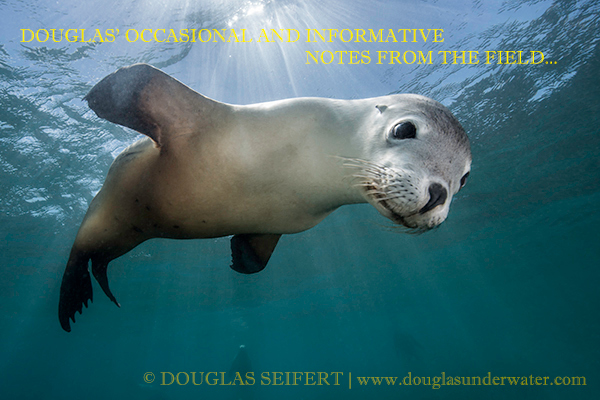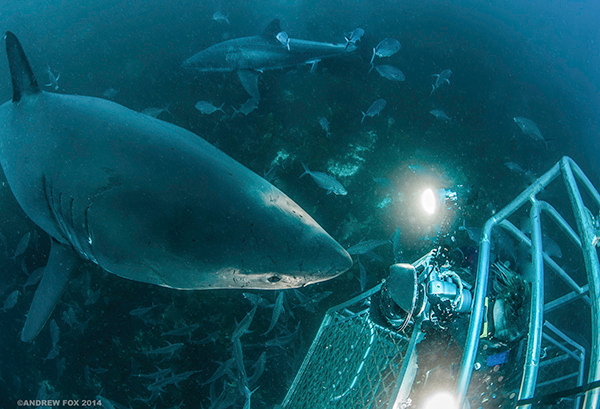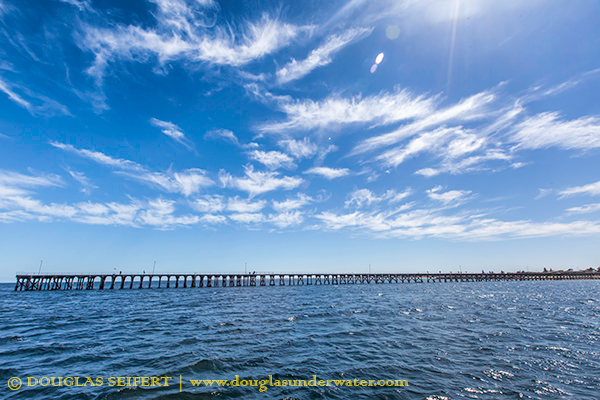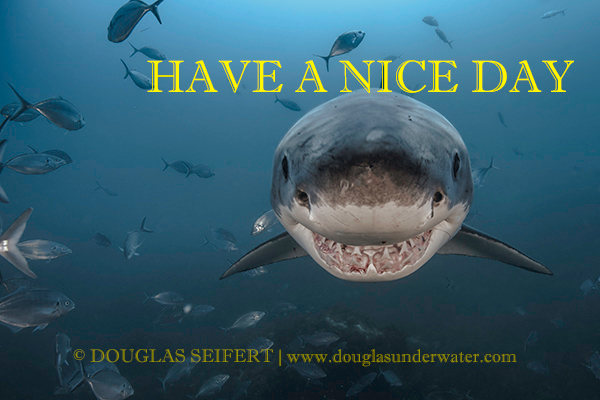Douglas Seifert’s illustrated notes from the field: Part 2

Intro and musings:
This expedition is a bit of a homecoming. I first visited South Australia in 1986 to dive with great white sharks (Carcharodon carcharias) on a Sea and Sea Travel expedition led by Carl Roessler and hosted by Rodney Fox and his son Andrew. Cage diving with great white sharks was a very extreme adventure in those days; there was probably less than 100 people in the world who had done it. Andrew and I have grown older and, well, grown, but it’s still one of the most exciting and most enjoyable experiences a nature enthusiast can have.
On my first trip, we went out on a chartered tuna boat called the Nenad that was more or less cleaned up to accommodate the passengers. In 1986, great white shark diving was like the Holy Grail of diving, so you could ride on the tales these encounters generated for years. Back then, divers carried Nikonos cameras with 36 exposures on a roll of film. Images were hard won and rare. Latterly, discounted, backpacker-style operations in the murky waters of storm-lashed South Africa as well as successful expeditions to North America’s close neighbor Guadalupe have sprung up, tens of thousands have now had the opportunity to see (and photograph and GoPro and post to YouTube and stop me when you’ve had enough: I’ve had enough) great white sharks for themselves. Progress can be a good thing and now it seems the Holy Grail has moved on to bizarre macro creatures living in the toxic waste waters of Indonesia, or maybe still large pelagics and cetaceans.
Currently, Andrew Fox’s operation is still the only white shark diving company in the world that offers a cage dive submerged to the bottom for a unique view of the predator in its natural environment. A whole new perspective and an interesting chance at close encounters. Sometimes, too close.

I met Valerie and Ron Taylor on a subsequent visit to South Australia searching for white pointer sharks over 20 years ago. We hit it off instantly and became close friends and dive buddies/expedition teammates ever since. They informally adopted me as a nephew and Valerie gave her approval when I first met Emily, my very patient wife and dive buddy and spotter. It was only fitting Valerie should join us for this expedition, to share the adventure and the laughter, as well as advise us whilst simultaneously creating her magnificent watercolor paintings. In 2012, the government of South Australia honored the Taylors for their lifelong career in underwater exploration and conservation by designating the Neptune Islands as the “Ron and Valerie Taylor Marine Park,” a marine sanctuary where commercial activities are strictly regulated and the protected great white shark can flourish.

VERY IMPORTANT: White sharks have been protected in Australia since 1997; however the Government of Western Australia is carrying out an illegal “culling program” as a knee-jerk response to a few fatal shark encounters on the WA coast over the past five years. All the scientists consulted by the government are against the use of drum lines along public beaches to kill sharks, pointing out that it will kill sharks but it will also effectively act as chum to bring sharks close into shore. So, it’s illegal (killing an endangered and protected species), it will not work and it makes no sense. This cull must be stopped by all means necessary. You can get involved via Sharksavers or via the petition on Change.org.
January 2014 – South Australia
After two days of great white shark adventures, we reluctantly left the Neptune Islands to begin our “Jetties of South Australia” Expedition™ by actually going to the Jetties as planned. I have always felt it is essential to have A Plan. Then you have a course to deviate (from if conditions warrant) and a general idea what you want to do, where to go and what to see. But first, we had to stop at Hopkins Island to dive with Australian Sea Lions (Neophoca cinerea). I guess it could be defined as being “on the way” if you drove the boat that way, or really, really, really wanted to swim with sea lions.
Do blondes have more fun? If the behavior of the Australian Sea Lions are any indication, the answer is yes, yes, and again yes! They are the most beautiful of pinnipeds, as playful and active as Labrador retrievers, that is if dogs could hold their breath underwater and swim as fast as torpedoes. The sea lions either initiate contact or ignore you, there is nothing in between. Fortunately they were in a playful mood for our one-hour dive and only when the sea lions would suddenly disappear did it occur to you that you were less than six kilometers from the Neptune Islands and what makes you think sharks don’t cruise the sea lion cafeteria you are now flailing around in, over-weighted to sit on the bottom, bundled up in thick rubber and seeing life through the tunnel vision of a mask or worse, a camera viewfinder…. That certain “Player One has Entered the Food Chain Game” creepy factor is one of those unanticipated aspects of diving South Australia that makes you realize that the unknown is just beyond visibility.
We crossed Spencer Gulf overnight and arrived at Port Hughes on the northwestern coast of the Yorke Peninsula. Expectations were riding high for frogfish (called anglerfish in Australia, where also toadfish are called frogfish and pufferfish are called toadfish, are you confused enough now? Aussies!), blue-ringed octopus, nudibranchs, seahorse, pipefish, sea dragons and more.

These fishing piers provide structure and habitat and attract sea life from miles around. The bottom is very shallow, a mix of sand and mud, boulders and sea grass sloping very gradually out for a long distance from shore. These wooden jetties were constructed in the previous century or earlier to allow cargo and grain shipments to be offloaded onto these remote peninsulas when roads were scarce or non-existent. There are more than two dozen such jetties in South Australia, some are better than others for sea life, depth, accessibility and variety.
Our first dive under the Port Hughes Jetty rewarded us with…..
To be continued:
